Whether we’re shopping, searching for information, or connecting with our favorite brands, the mobile experience is a paramount consideration. As marketers, we understand the necessity of meeting our audience where they are, and increasingly, they’re on their smartphones and tablets.
However, website mobile optimization isn’t always a straightforward task. It’s a pain point that marketers often grapple with, and it’s crucial to address it effectively. In this comprehensive article, we’re going to explore a powerful solution to this challenge: Pathmonk Intelligence.
With mobile optimization in mind, we’ll delve into how Pathmonk Intelligence can assist you, and provide a step-by-step roadmap for success.
Step by Step: Optimizing for Mobile Users with Pathmonk Intelligence
When it comes to understanding mobile user behavior, Pathmonk Intelligence is a powerful yet simple tool that allows you to gain deeper insights. This is a detailed breakdown of how to access mobile users’ insights easily:
1. Analyzing Your Pages Mobile User Behavior
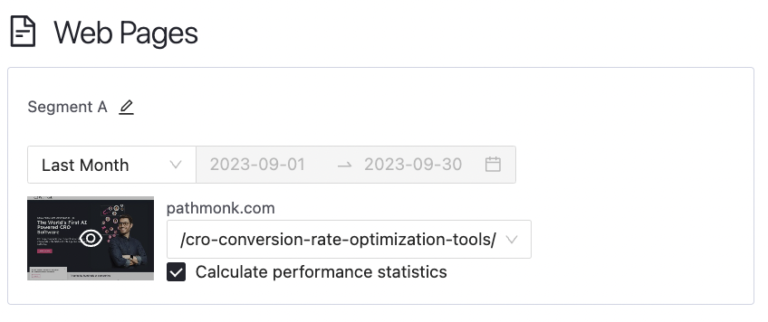
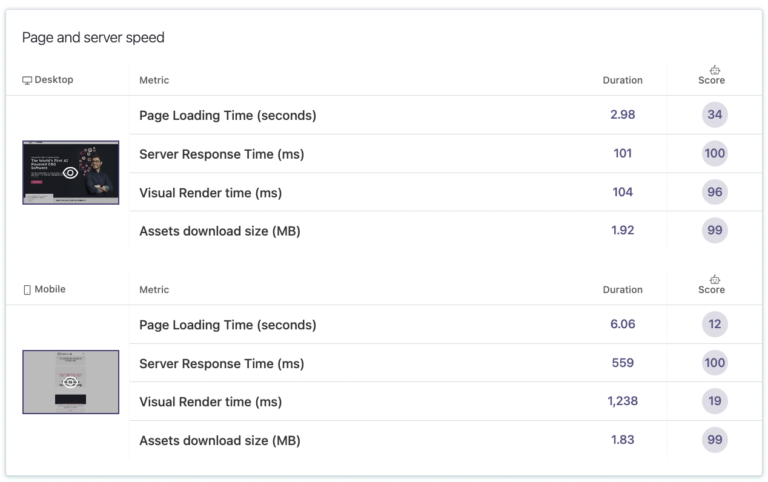
In your Pathmonk Intelligence left menu, navigate to the Web Pages report. Here, you’ll be able to filter each one of your pages and select the dates in which you want them analyzed.
For every page analyzed, Pathmonk Intelligence provides Page and server speed information, enabling a detailed comparison between desktop and mobile performance. This section highlights opportunities to improve mobile site speed, a critical aspect of mobile optimization, and allows you to identify specific pages on your site that may be slow to load on mobile devices. Address these issues to improve the mobile user experience.
The Pathmonk score on the right side refers to the suitability of each KPI. This feature allows you to identify which pages perform optimally and which may require attention, so you can prioritize your optimization efforts effectively.
Understanding the speed discrepancies between desktop and mobile experiences empowers you to pinpoint areas for improvement. This directly translates to a smoother, more engaging user experience, ultimately driving higher conversions.
2. Buyer Persona Information
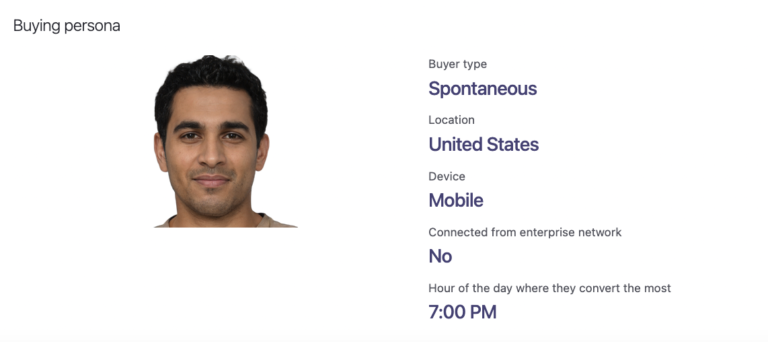

In the Buyer Persona report you’ll gain valuable insights into how your typical customers connect with your business, whether through desktop or mobile devices.
This section of the report goes beyond the surface, offering a deeper understanding of your audience. By focusing on demographic details and their unique conversion journeys, you’ll gain a deeper understanding of your customer personas.
3. Content Optimization Insights for Mobile Users
Another useful feature of the Buyer Persona report is the Buying Modalities matrix and the How to Target strategy. This section will equip you with a 360° view of your audience and actionable insights on how to engage them effectively.
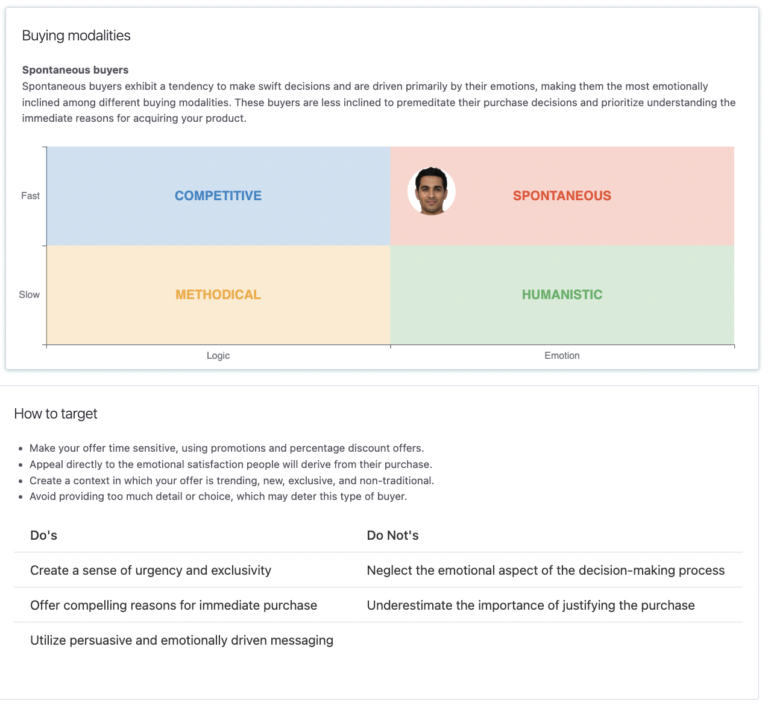
By embracing these insights, you can craft targeted strategies that not only resonate with your personas but also lead to higher engagement and conversion rates, driving the success of your marketing efforts.
4. Regularly Review Reports
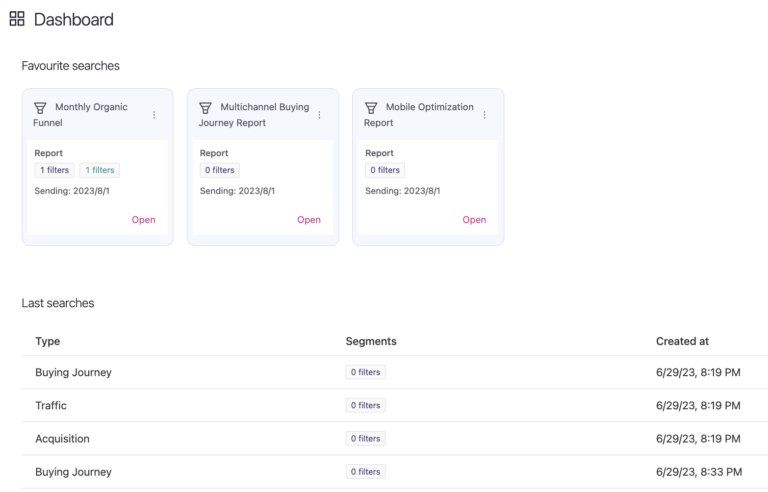
Create a custom report and make it a habit to review mobile reports in Pathmonk Intelligence regularly. Continuously track your mobile optimization efforts, assess their impact, and refine your strategies based on data-driven insights.
Understanding the Mobile User Experience
Why should marketers pay such close attention to the mobile user experience? The numbers tell the story:
- Mobile Dominance: Mobile devices have overtaken desktops as the primary means of internet access for a vast majority of users. With the proliferation of smartphones and tablets, more people are browsing, shopping, and interacting with websites on their mobile devices than ever before. Failing to cater to this audience means missing out on a significant portion of your potential visitors and customers.
- Improved User Experience: A mobile-optimized website provides a seamless and user-friendly experience for mobile users. It ensures that your content, images, and navigation are tailored to smaller screens and touch-based interactions. A positive user experience is essential for retaining visitors, reducing bounce rates, and encouraging engagement and conversions.
- Higher Search Engine Ranking: Search engines, particularly Google, have adopted a mobile-first indexing approach. This means that they prioritize the mobile version of your website when determining search engine rankings. A mobile-optimized site is more likely to rank higher in search results, increasing your visibility and attracting more organic traffic.
- Faster Page Load Times: Mobile users expect websites to load quickly, even on slower mobile data connections. Mobile optimization often involves compressing images, minimizing code, and improving server response times, resulting in faster load times. Speed is not only crucial for user satisfaction but also for search engine rankings.
- Enhanced Mobile Commerce: With the rise of mobile eCommerce, a mobile-optimized website is essential if you’re looking to tap into this market. A smooth and secure mobile shopping experience can significantly boost sales and conversion rates.
- Reduced Bounce Rates: If your website is not optimized for mobile, users are more likely to leave your site quickly if they encounter difficulties in navigation or if the content doesn’t display properly. This results in high bounce rates, which can negatively impact your website’s performance and search engine ranking.
- Competitive Advantage: Many of your competitors are likely optimizing their websites for mobile. Failing to do so puts you at a disadvantage in the market. Users will choose competitors with better mobile experiences, leading to lost opportunities and potential customers.
- Positive Brand Image: Providing a well-optimized mobile experience contributes to your brand’s reputation. Users are more likely to trust and engage with a website that works flawlessly on their mobile devices. Positive user experiences can lead to increased brand loyalty and positive word-of-mouth marketing.
Mobile users are a distinctive segment of your audience. Here are some key characteristics that set them apart and should be taken into account when preparing any marketing strategy:
- On-the-Go Accessibility: Mobile users often access websites while on the move. This means they might have limited time and attention, making quick and efficient interactions a priority.
- Varying Screen Sizes: Unlike desktops, mobile devices come in various screen sizes and orientations. This diversity adds complexity to design and user interface considerations.
- Touch-Based Interactions: Most mobile devices rely on touchscreens, introducing a different interaction model compared to mouse and keyboard. This affects how users navigate and engage with your website.
- Local Relevance: Mobile users often seek location-specific information, making geolocation and personalization essential for enhancing their experience.
- Multitasking: Mobile users are known for multitasking. They might be watching TV, chatting, and shopping simultaneously. Understanding how to engage with them in such contexts is crucial.
- Data Constraints: Mobile data plans vary in terms of speed and data limits. Optimizing for performance and efficiency is paramount to accommodate users with limited data resources.
Pathmonk Intelligence: The Solution for Mobile Optimization Insights
Pathmonk Intelligence provides you with a powerful lens into the actions and behaviors of your mobile users. It allows you to track how they engage with your content, where they spend their time, and what actions they take.
Pathmonk Intelligence’s key features include:
- Cookieless Technology: Pathmonk Intelligence operates entirely without cookies, ensuring strict adherence to changing privacy regulations. This sets it apart from traditional analytics platforms, making it a trusted choice for user data protection.
- User Experience and Interface: Pathmonk Intelligence places a strong emphasis on providing a user-friendly and intuitive interface. This focus makes it easier for marketers and analysts to extract valuable insights without the need for a steep learning curve, enhancing the overall user experience.
- Mobile-Centric Features: Pathmonk Intelligence offers features specifically designed for mobile analytics and user behavior tracking. This specialization gives it a distinct advantage in the mobile domain, where understanding and optimizing mobile interactions are paramount.
- Cross-Device Tracking: Pathmonk Intelligence’s advanced machine learning algorithms enable the tracking of users across different devices seamlessly. This cross-device tracking capability provides a comprehensive view of user interactions and journeys, regardless of the device used.
- Deeper User Behavior Insights: Pathmonk Intelligence provides advanced tracking and analytics options that allow for a deeper understanding of user behavior. Features like touch and gesture tracking, user session recordings, and in-app event tracking offer richer insights into mobile user interactions.
- Customer Support and Training: Pathmonk Intelligence provides personalized customer support and training resources, which can be particularly valuable if you’re seeking assistance in using the tool effectively. The responsive support and guidance from Pathmonk Intelligence can expedite the learning curve and ensure that you make the most of the tool.
How to Add Pathmonk Intelligence to Your Marketing Strategy
Step 1: Free Demo and Sign-Up
If you want a hands-on test of how Pathmonk Intelligence works and what it can do for you, sign up for a Free Demo. This hands-on experience will provide you with valuable insights into how Pathmonk Intelligence can work to your advantage.
Alternatively, you can directly start your journey with Pathmonk Intelligence by signing up for an account.
Step 2: Onboarding and Installation
Once registered, the next step is to integrate Pathmonk Intelligence with your platform.
The onboarding process has been designed to be exceptionally user-friendly, making it a self-service experience that ensures you’re up and running smoothly.
Step 3: Data Configuration
Your business is one-of-a-kind, and so are your objectives. We encourage you to customize your data collection settings to precisely align with your unique business goals. This level of customization empowers you to tailor your goals, ensuring that you receive the most relevant insights that will truly impact your success.
You have the flexibility to establish your goals using various methods: through a URL, a pixel that doesn’t rely on cookies, or by integrating with a third-party application.
Applying Pathmonk Intelligence Mobile Optimization to Your Marketing Strategy
With the wealth of insights extracted from Pathmonk Intelligence, you have a powerful tool at your disposal. This is how these insights can be effectively applied to enhance your marketing strategy in the context of mobile optimization.
- User Behavior Analysis: Use Pathmonk’s user behavior insights to understand how mobile visitors interact with your site. Identify popular pages, frequently accessed content, and common navigation patterns specific to mobile users.
- Conversion Funnel Optimization: Based on Pathmonk’s data, refine your mobile conversion funnel. Identify friction points and areas where users may drop off, and implement optimizations to guide them toward desired actions.
- Content Personalization: Leverage the personalization capabilities of Pathmonk to tailor content for mobile users. Serve up dynamic, relevant content that aligns with their preferences and behavior, creating a more engaging mobile experience.
- Mobile-Specific CTAs: Use insights from Pathmonk to refine your mobile calls-to-action. Understand which CTAs resonate most with mobile users and strategically place them within the mobile interface for maximum impact.
Exploring Pathmonk Intelligence Mobile Optimization Use Cases
Pathmonk Intelligence plays a pivotal role by providing actionable analytics and insights for improving mobile user experiences. These are some real use cases from clients in various sectors:
eCommerce and Retail
An e-commerce company using Pathmonk Intelligence to analyze mobile user behavior discovered that mobile users frequently abandoned their shopping carts on the payment page. By identifying this issue, they optimized the mobile payment process, implemented a simplified and user-friendly design, and saw an immediate 20% increase in mobile conversion rates.
Healthcare and Telemedicine
A telemedicine platform leveraged Pathmonk Intelligence to understand mobile user preferences, and realized that mobile users were dropping when selecting the appointment. They discovered there were some usability issues with drop-down menu affecting certain devices. In response, they redesigned that page with more mobile-friendly elements, which resulted in an 80% increase in mobile appointment bookings.
Travel and Hospitality
A hotel chain using Pathmonk Intelligence found that users often abandon bookings during the price selection step. They simplified the mobile booking process, reducing the number of steps required for selection, leading to a 15% increase in mobile bookings.
Financial Services
A financial institution using Pathmonk Intelligence examined mobile user interactions for new accounts. They discovered that mobile users are more likely to explore investment options on weekends. Consequently, they adjusted their mobile content delivery schedule, resulting in a 10% increase in mobile account openings.
Understand your customer journey analytics
See how your users behave, find drop-offs, and receive actionable insights with AI.






